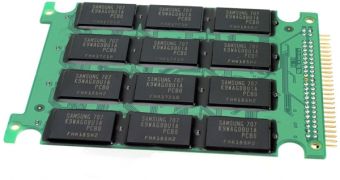The NAND flash memory has firmly set foot in both IT and consumer electronics industries. It is present almost everywhere, from the recent solid-state drives to portable MP3 players, mobile telephones or digital cameras. It is the perfect storage medium, as it is extremely power-efficient, dense and shock resistant. However, it was quite expensive, but recent price drops put it to new use.
While 4GB single-level cell (SLC) NAND flash memory chips sold for $18.50, DRAMEXchange clearinghouse reports that it can now be purchased for as little as $4.96. The price for 4GB multi-level cell (MLC) NAND flash chips also went down, which made the NAND Flash industry almost collapse.
Single-Level Cell NAND is more expensive than the Multi-Level Cell memory, because there are significant improvements in its lifespan. The SLC NAND may cost three times more than MLC memory, but it has ten time its lifespan, with a lifetime of 100,000 write cycles (as comparad to MLC's 10,000 write cycles).
Toshiba and Samsung have built new solid-state drives based on the cheaper multi-level cell technology. They both have announced 128GB SSDs with smaller prices, to be used especially in notebook configurations. "At 128GB, you're giving consumers the kind of storage space they expect in a notebook," said Jim Elliott, director of flash marketing at Samsung.
Using MLC NAND Flash might seem a little strange, since it is not too reliable and might lead to serious data loss after the 10,000 write cycles have been performed. However, Toshiba and Samsung worked around this issue and used controller chips that are alleged to avoid wearing out a single portion of the disk before its time.
According to Elliott, the solid-state drives will "eat up" 27 percent of the total NAND production by 2011 and will be implemented mostly in business laptops and mobile devices.
SanDisk took another approach at storage, and released a 72GB SSD that is allegedly thinner and lighter than the conventional 2.5-inch devices from Samsung and Toshiba. SanDisk's storage device is aimed at the mobile market. According to Iri Trashanski, director of strategic business development at SanDisk, the 72GB SSD will be the end of the line, because there will be no market for 128GB SSDs for a while.

 14 DAY TRIAL //
14 DAY TRIAL //